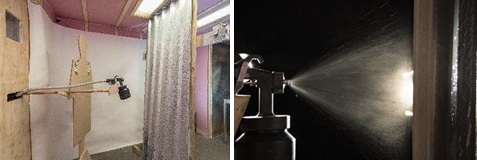Industrial application of moisture cure polyurea coatings: Assessing potential exposure to airborne isocyanates

The Challenge
Our client intended to apply moisture cure polyurea coating
products using specialised spray equipment, and they wanted to
ensure that the risk of isocyanate exposure to their workers
was adequately controlled.
Isocyanates are a primary component of these products and can
also be found in a number of construction products including
polyurethane paints, coatings, foams, glues and flooring. Certain
tasks, such as spraying, can produce very high exposure to
isocyanates.
Isocyanates can affect your health in a number of ways. They can
cause:
- irritation of the eyes, nose and throat
- dermatitis - for more information on the effects of dermatitis
see this video, worker's story and pictures
- occupational asthma - this is a significant risk for workers
spraying isocyanates
The Control of Substances Hazardous to Health (COSHH)
Regulations states that employers must protect workers against the
risks of isocyanates and, in Great Britain, a workplace exposure
limit (WEL) of 20 µg/m3 (8-hour time weighed average)
has been set.
Moisture cured polyurea coating products are formulated
with a range of polymeric isocyanates and some also contain high
levels (>50%) of a powdered metal to provide anticorrosion
properties. Although polymeric isocyanates are less volatile than
monomeric isocyanates, significant airborne levels can still be
generated depending on the application method. Consequently,
measuring exposure can be challenging, particularly as current
biological monitoring methods only measure monomeric isocyanate and
material safety data sheets may only identify polymeric species
generically. Underestimates of isocyanate exposure are
possible.
The Solution
In discussion with the client, a phased programme of work was
agreed to ensure that they would have the relevant information to
carry out a thorough risk assessment for application of the new
proposed coating.
Firstly, our analytical team analysed four different coating
products. Two contained high levels of a metallic powder, which was
found to interfere with the analysis, so a method was developed to
remove interferences. The safety data sheets only provided generic
information about the isocyanate present within each sample. MDHS 25/4 methods were therefore used to
characterise the specific polymeric species within the bulk
samples. Confirmation that all the isocyanate (as the chemical
group -NCO) was accounted for was determined by titration.
Secondly, following successful characterisation of the bulk
materials, a spray booth was set up to model the client's spray
application under controlled conditions, to evaluate likely
exposures. The client's specialised spray equipment was used under
their guidance to make the scenario as representative of real world
conditions as possible.
The Outcome
For each of the four moisture cured polyurea
coating products tested, airborne isocyanate was measured at
levels in excess of the WEL. A significant health risk was
identified not only for the person carrying out the spraying but
also for those close by.
Because we used the client's own spray equipment and worked
closely with them to ensure the appropriate application scenario
was used, we were confident that the measurements provided an
accurate assessment.
Our client was then able to review their risk assessment,
consider exposure controls and assess the practicalities around
application of the MCU products to ensure compliance with
regulations and to protect the health of their workforce.
For more information about how we could do something
similar for you, email our
Sample Registration team or contact us via the enquiry
form.
Back to the top